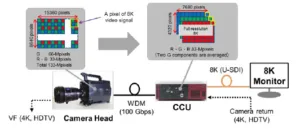Tomohiro Nakamura from NHK Science & Technology Research Laboratories described their new 8K portable camera. NHK has already developed a conventional 3-chip 8K broadcast camera, but it very large and expensive, so they developed this new camera based upon a single chip using an RGGB Bayer filter.
The camera features a 133-megapixel 60 Hz CMOS sensor. But the data rate of the sensor did not support readout at 120 Hz, so they team came up with an interlaced image capture technique that can allow capture of an 8K 120 Hz image.
As shown in the system diagram, the camera is coupled to the Camera Control Unit (CCU) via a 100 Gbps optical fiber (using the SMPTE approved U-SD protocol), and to an 8K monitor using a similar fiber bundle. The camera supports HLG and wide color gamut. The CCU provides the de-Bayering function and sends back a 4K image for the camera viewfinder.
The pixel count of the camera sensor is 1536 x 8640 with a pixel size of 2.45 x 2.45 microns. The active area corresponds to a 35 mm full frame format. The delivered image is 7680 x 4320, 12-bit, 60 Hz.
For 120Hz operation, the sensor can read two lines at a time, skipping the next two lines at 120 Hz. The next cycle reads the lines that were skipped. Thus pixel integration time is 1/120 second. Motion in the vertical direction is compromised due to the interlaced capture, so the CCU provides motion-based frame interpolation in this direction to create full frame images that are presented at 120 fps.

NHK did some imaging tests with the camera as well and confirmed the resolution characteristics of the single-chip camera was the same or better than the three-chip version at 60 Hz, while the MTF of the 120 Hz performance was the same as at 60 Hz. – CC

